INTRODUCTION
The departments of physical education are the departments and faculties related to physical education at each university, and students preparing to apply for physical education departments must also take the physical fitness test designated by each university.1 Most physical education entrance exam students force training in a state where injuries and pain have accumulated and have not fully recovered, causing secondary damage.2 Many sports injuries occur in the ankle joint because it is an important joint that supports body weight and controls lower limb movements during exercise.3 Ankle ligament injuries are damages to the lateral ligament structures caused by sudden plantar flexion and inversion of the ankle joint.4 Among them, the anterior talofibular ligament is the most frequently damaged, and 10-50% of patients who experience ankle sprains experience chronic ankle sprain symptoms,5 resulting in functional ankle instability.6
Functional ankle instability is the joint instability caused by incomplete recovery of proprioception following an acute ankle sprain.7 This instability can affect the mechanical relationship between the ankle joint, knee, back, and spine, leading to negative impacts.8 Previous studies have highlighted the effectiveness of proprioceptive neuromuscular control exercises focusing on plantar flexion and dorsiflexion,9 ankle muscle strengthening, agility-related functional exercises,10 and kinesio taping.4 Additionally, several studies have reported changes in hip joint muscle activity and strength in patients with functional ankle instability, beyond just the ankle joint.11-13
Recently, research on hip joint muscles for the treatment and prevention of lower limb injuries has been emphasized,14 and it has been argued that continuous interaction between ankle and hip muscles is necessary.15 Additionally, proprioception, which is responsible for postural control and maintenance in the human body, is known to decrease with the severity of ankle injuries.16 Closed kinetic chain exercises have a significant impact on many rehabilitation programs,17 as they are performed in weight-bearing postures, stimulating joint and muscle mechanoreceptors and promoting co-contraction of agonist and antagonist muscles, thereby increasing dynamic stability.18 Exercises in unstable environments can maximize exercise effectiveness by stimulating the neuromuscular transmission system, inducing muscle co-contraction, and enhancing muscle mobility and stability through co-contraction of agonist and antagonist muscles.19,20
Balance cushion exercises applied to individuals with functional ankle instability focus on deep muscle movements and are reported to be effective as exercises that require the tension of the entire body on an unstable support surface. Exercise therapy using slings also effectively strengthens the core muscles by utilizing hanging ropes,21 and provides an unstable support surface that stimulates the neuromuscular transmission system, allowing for sensory-motor training.22 It has been reported to increase postural control and dynamic balance ability by reactivating the dynamic and static contraction of muscles inhibited due to pain.23 While many studies have investigated the effects of balance cushion and sling exercises on hip and trunk stabilization influencing static and dynamic ankle balance, comparative studies of these two exercises and studies targeting college entrance examinees are limited. Therefore, this study aims to investigate the effects of balance cushion and sling exercises on static and dynamic balance in college entrance examinees.
METHODS
This study was conducted with 45 high school students with functional ankle instability enrolled at R Physical Education Academy in Daegu. The inclusion criteria were a score of 24 or below on the Cumberland Ankle Instability Tool (CAIT) and having experienced ankle instability, pain, or wobbling of the ankle joint within the past 6 months. Symptoms had to be maintained for at least one week before the start of the study.24 Exclusion criteria included individuals with a history of lower limb surgery, balance impairments, recent treatments affecting balance within the last month, or neurological abnormalities causing sensory changes or muscle paralysis. Participant characteristics are shown in Table 1. Ethical approval for this study was obtained from Daegu University (1040621-202407-HR-050), and consent was obtained from all subjects before data collection began. Of the 45 college entrance examinees with chronic ankle instability, 15 performed closed kinetic chain exercises for the hip joint on stable surfaces, 15 performed the exercises on balance cushions, and the remaining 15 performed the exercises on slings.
In this study, the exercise program was reconstructed with reference to previous research: the effectiveness of rehabilitation programs for postural control and lower limb function in individuals with functional ankle instability,25 exercises that minimize the activation of the tensor fasciae latae while maximizing gluteal muscle engagement,26 and exercises for strengthening the gluteus maximus and promoting neuromuscular re-education.27
The exercise program consisted of a warm-up, main exercises, and a cool-down phase, with a total exercise duration of 40 minutes per session, performed three times per week for four weeks. For the warm-up, participants marched in place for 5 minutes before the main exercises. The main exercise session included four types of exercises. One exercise was the same for all three groups, while the remaining three exercises differed between the groups. The dorsiflexion exercise and the ankle inversion and eversion exercises were performed identically by all three groups (Figure 1). On a stable surface, participants performed pelvic lifting exercises in the supine position, hip abduction exercises in the side-lying position, and hip adduction exercises in the side-lying position (Figure 2). On a balance cushion, participants performed the same exercises in the same positions (Figure 3). Additionally, using a sling, participants performed pelvic lifting exercises in the supine position, hip abduction, and hip adduction exercises in the side-lying position (Figure 4). For the cool-down, participants performed simple stretching and deep breathing exercises. A 30-second rest was given after each set.
Dynamic balance ability changes before and after the exercise were measured using the star excursion balance test. This evaluation helps predict muscle strength, joint range of motion, and proprioception since maintaining the movement and balance axis within the body's base of support in a single-leg stance requires efficient muscle movement and neural control of the weight-bearing leg.
Although the test typically involves measuring all eight directions drawn at 45-degree intervals, this study reduced the star excursion balance test to three directions (anterior, posterolateral, and posteromedial) to shorten the time and avoid unnecessary physical fatigue. Participants were instructed to place their measuring foot in the center, hold their hips with both hands, and reach as far as possible in each direction while the distance from the center to the tip of the opposite foot's big toe was measured.
Static balance ability changes were measured using a single-leg stance test on a Wii balance board with built-in Bluetooth functionality. To quantify the measured values, a balance ability analysis program was used. Participants stood on one foot on the balance measuring equipment for 5 seconds, then put their leg down. During this time, the analysis program measured the center of pressure sway distance in the X and Y axes, sway velocity, and the 95% confidence ellipse area.
In this study, the data were expressed as mean ± standard deviation. All data were tested for normal distribution using the Kolmogorov-Smirnov test. A two-way repeated ANOVA was performed to compare changes in dynamic and static balance abilities across three support surfaces. If significant variations were found, a one-way ANOVA was conducted to compare differences between groups. All data in this study were analyzed using IBM SPSS Statistics 23.0 (SPSS Inc, Chicago, IL).
RESULTS
In the comparison of changes in the anterior distance, posterior-medial distance, and posterior-lateral distance in the star-shaped balance test before and after intervention, all groups, including stable surface, balance cushion, and sling exercise groups, showed statistically significant differences (Table 2). In the between-group comparison, both the balance cushion and sling exercise groups showed significant differences from the stable surface exercise group in the posterior-medial and posterior-lateral distances before and after the intervention (Figure 5 and 6). In the comparison of changes in the center of pressure (CoP) migration distance, migration speed, and migration area before and after the intervention in the one-leg standing test, the balance cushion exercise group and the sling exercise group showed statistically significant differences (Table 3). In the comparison between groups, there were also significant differences between the stable surface exercise group and the balance cushion and sling exercise groups before and after the intervention (Figure 7,8 and 9).
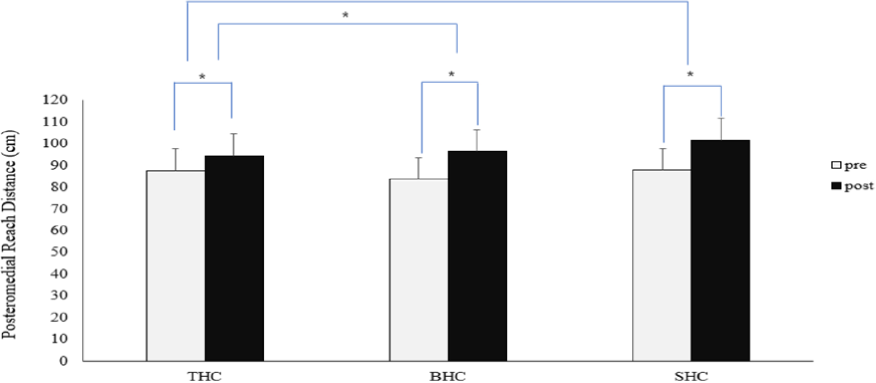
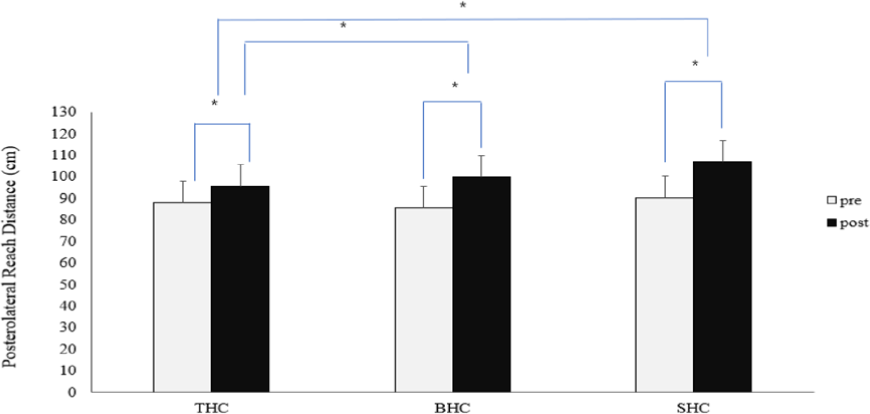
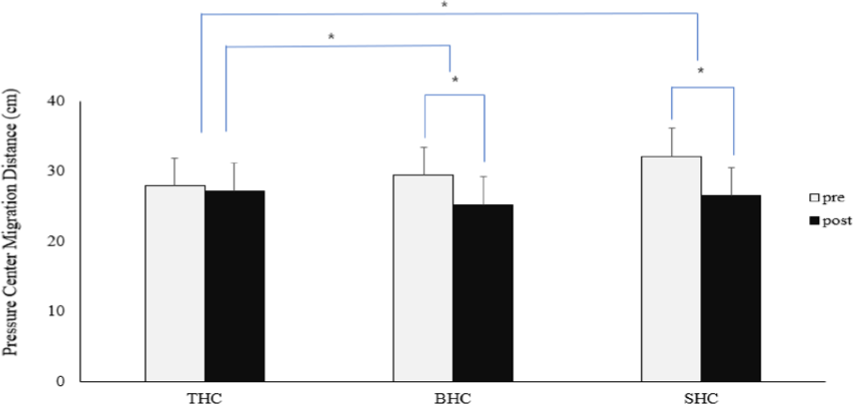
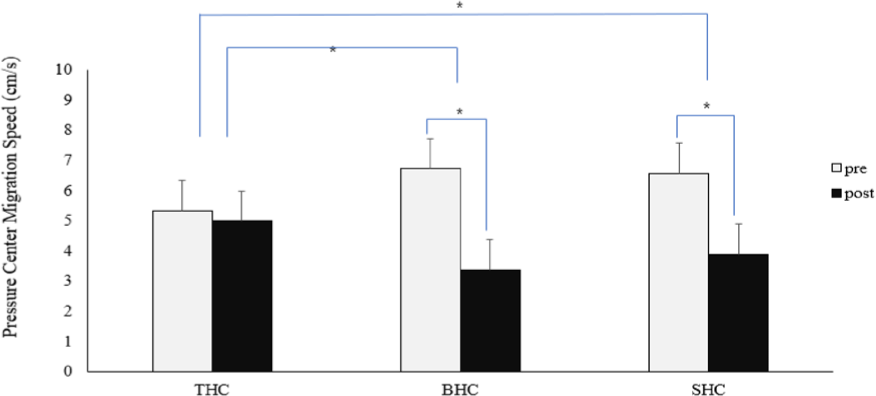
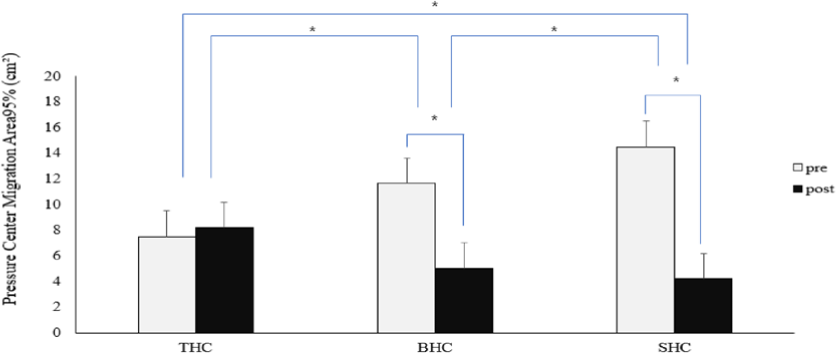
DISCUSSIONS
This study compared the effects of closed kinetic chain exercises for the hip joint performed on stable surfaces, balance cushions, and slings on static and dynamic balance abilities in 45 college entrance examinees with functional ankle instability. It was confirmed that closed kinetic chain exercises performed on balance cushions and slings were more effective. These results suggest that closed kinetic chain exercises for the hip joint on balance cushions and slings should be recommended in rehabilitation programs to treat patients with functional ankle instability.
In the Star Excursion Balance Test, which is used to evaluate dynamic balance ability, all groups (stable surface, balance cushion, and sling) showed significant increases in reach distances in the anterior, posteromedial, and posterolateral directions. In the comparison between groups, the balance cushion and sling groups showed greater improvements in the posteromedial and posterolateral directions compared to the stable surface group. These findings are consistent with previous research indicating that balance exercises on unstable surfaces are more effective than those on stable surfaces,28 and also align with prior studies suggesting that ankle muscle strengthening and proprioceptive training programs are effective in improving dynamic balance ability.29
In the single-leg stance test, used to evaluate static balance ability, the balance cushion and sling groups showed decreases in center of pressure sway distance, sway velocity, and the 95% confidence ellipse area, while the stable surface group showed no significant changes. This is consistent with a previous study which reported that training on an unstable support surface using a balance cushion helps restore proprioception and reduces the contraction delay time of muscles around the ankle.30 Additionally, it aligns with the findings of the study, which reported that exercises performed on unstable surfaces stimulate the neuromuscular transmission system, induce simultaneous contraction of agonist and synergist muscles, enhance stability and balance ability, and maximize exercise effectiveness.22
This study had several limitations. First, due to the characteristics of the participants, who were students preparing for the physical education college entrance exam, it was difficult to control other physical activities outside of the experimental training. Second, because the exercise program consisted of various movements, it was challenging to determine which specific movement training affected the specific outcome values. Third, a short training period of four weeks was insufficient to meet the required duration for an adequate exercise program. Fourth, biomechanical data were not included to clarify the underlying mechanisms. Future research should address these limitations by developing exercise programs that enhance single-leg stance ability, which is crucial for walking and running, in order to improve functional ankle instability. More subjects and studies that include various postures and movements are needed, and individualized exercise programs tailored to each person's functional level and characteristics should be developed. Additionally, precise experimental designs based on detailed motion analysis are required.
CONCLUSIONS
This study investigated the effects of closed kinetic chain exercises for the hip joint on different support surfaces on static and dynamic balance abilities in college entrance examinees with functional ankle instability. It was found that the balance cushion and sling groups were more effective than the stable surface group in reducing the posteromedial and posterolateral distances in dynamic balance ability, as well as the center of pressure sway distance, sway velocity, and the 95% confidence ellipse area in static balance ability. The differences between the balance cushion group and sling group were only observed in the 95% confidence ellipse area for static balance ability, with the rest of the measurements showing similar results for both groups. It can be concluded that closed kinetic chain exercises for the hip joint using balance cushions and slings on unstable surfaces are effective in improving the function of patients with functional ankle instability. Therefore, applying exercises that are easily accessible to individuals with ankle instability could help reduce the frequency of re-injury and stabilize ankle instability, thereby aiding functional improvement.











